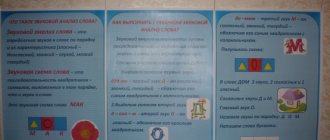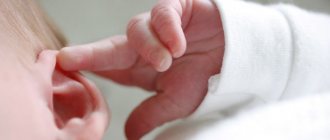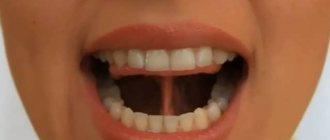Phonemic hearing is directly related to physiological hearing, that is, to the innate ability to hear various sounds of the outside world. The difference between them is that the first one helps not only to hear, but also to analyze information. Phonemic perception in speech therapy is a narrower concept that includes distinguishing by ear the main parts of a word (syllable, sound), differentiating speech and non-speech sounds, determining the strength and timbre of the voice and much more. If the perception of phonemes is not formed for a number of reasons, then a violation of the syllabic and sound components of the language occurs.
Formation of phonemic awareness/hearing
In a preschool institution, work on the formation of the phonemic aspect of speech is carried out gradually, starting from an early age. But the development of phonemic hearing up to one year can be considered a fundamental stage:
- Already at two months of age, the baby, with normal development of physiological hearing, distinguishes the mother's voice.
- By three months of age, the baby determines where the sound is coming from and turns its head towards the stimulus.
- After another month, he already shows a reaction to the expressiveness of speech (the strength and intonation of the voice); he may be afraid of a loud sound or scream.
- At 5 months, humming is replaced by babbling. Six-month-old children with normal development listen carefully to the conversation, repeat sounds or direct open syllables after the adult.
- By eight months, the child begins to use only the sounds present in his native speech.
The correct development of phonemic hearing at 1-2 years will be evidenced by the child’s understanding of the adult’s speech addressed to him. In this case, it means following simple monosyllabic instructions (for example: “give me the car”, “bring the doll”), correctly understanding basic questions (“where is daddy”, etc.). With normal intelligence, by the age of three, phonemic hearing is almost formed, the baby distinguishes and corrects incorrect speech.
conclusions
Thus, the following conclusions can be drawn:
- The function of the child’s auditory analyzer is formed early, much earlier than the speech motor analyzer.
- Phonemic hearing consists of the ability to generalize different sounds into separate groups, to combine sounds, taking as a basis some essential features and ignoring other, random features.
- The process of speech perception is divided into two stages: prephonemic and phonemic.
- N. Kh. Shvachkin identifies 12 phonemic series according to the order of formation in children.
- Of all types of analysis of speech flow (dividing sentences into words, words into syllables, syllables into sounds), the most difficult is the phonemic analysis of words.
- Practical ideas about the sound composition of a language are formed on the basis of phonemic analysis and perception. Memory and attention play a significant role in this process.
Korchagina Larisa, teacher-speech therapist (St. Petersburg)
Phonemic awareness and hearing disorders in children
At primary school age, problems in the development of phonemic hearing and perception can be expressed not only in children’s oral speech, but also in written speech. This is evidenced by such violations as:
- Replacement, rearrangement or omission of individual letters in a word, sometimes entire syllables (porridge - kafa, ksha, aksha, etc.).
- Failure to pronounce words (toy - toy).
- Separation or merging of words when writing (in the forest - in the forest, train - on the train, etc.).
- Skipping a soft sign or, conversely, softening where it is not required (skates - skates, wound - wound).
- Semantic distortion (drying - ear, button accordion - ram).
The same thing happens when reading. Children with FPD (phonetic-phonemic disorder) often cannot merge sounds into syllables, and syllables into words: they read in a set of letters, change places, and do not read to the end. All this leads to difficulties in further education, as a result of which children begin to lag behind their peers.
Why is it necessary to develop it?
Without understanding the sound features of the speech of others, it will be difficult for a child to learn to speak. With developed phonemic hearing, the baby realizes that he is pronouncing the word incorrectly and tries to independently achieve the correct pronunciation. If the difference between similar sounds is not caught, stable substitutions “beetle - kuk”, “shishka - detective” are formed. The worse the phonemic hearing is developed, the more pronounced the speech problems. In such cases, they say that children feel like they have porridge in their mouth.
If a problem is not solved in preschool age, many new, much more serious ones arise from it. The child has difficulty reading, writing, and learning other languages. He has difficulty merging syllables, isolating individual sounds, he writes endings incorrectly, and much more. Schoolchildren begin to fall seriously behind in their school curriculum.
Causes and mechanisms of violations
In order to eliminate the problem, you need to know the causes of its occurrence. Delay or impairment of phonemic hearing and perception is not just pedagogical neglect, although this option may be appropriate.
The mechanisms of occurrence can be started even in intrauterine development. Therefore, it is necessary to know the root cause, since it is this information that will allow us to determine methods of working with the child: speech therapy assistance alone is not always enough; in some cases, drug treatment is also necessary.
The main causes of FFN in children include the following:
- Pathological changes in the ontogenesis of the fetus during the period of intrauterine development of the speech zones of the cerebral cortex or the formation of speech organs. This is especially pronounced in cases of disturbances in the structure of the articulatory apparatus, when a child is born with a gothic palate, cleft lip, cleft palate and other pathologies.
- Birth injuries, this also includes fetal asphyxia, incorrect position of the forceps at the moment when the doctor directs the fetus, prolonged, complicated labor. As a result, the functioning of speech centers may be disrupted.
- Viral, somatic or infectious diseases suffered in early childhood.
- Social factors contributing to the development of FFN: neglect, psychological trauma, fear, an unfavorable environment for speech development (parental deafness, lack of emotional connection between mother and child) and much more.
Having identified cause-and-effect relationships, specialists will be able to prescribe treatment if necessary and select appropriate corrective methods of work. In some cases, such as children with a cleft lip or cleft palate, surgery will be recommended. All these measures will help get rid of speech problems.
Corrective work with children with physical disabilities
If, based on the results of a psychological, medical, and pedagogical examination of speech, a diagnosis of FSD is made, the student will be sent to a speech therapy group to correct and eliminate the identified problem. If this happened in a timely manner and the baby has a mild or moderate degree of FFN, then there is every chance of eliminating the violations by the end of preschool age.
Speech therapy work with children suffering from delays in the development of phonemic perception and hearing is carried out systematically as part of the correctional program of the preschool educational institution. Individual work, depending on the specifics of the violations, is carried out in the following areas:
- Understanding spoken speech.
- Distinguishing between speech and non-speech sounds: at this stage, depending on age, musical instruments, listening to the sounds of nature and its phenomena (murmur of water, chirping of birds, thunder, rain, etc.), everyday noises (knocking on the door, sounds of people working) can be used. devices, telephone call).
- Correction of perception of words similar in pronunciation, but different in meaning (butterfly - grandmother).
- Distinguishing words that differ from each other in only one sound (bow - hatch, shelf - stick, magpie - hassle).
- Work on the replacement and differentiation of paired sounds (b-p - barrel - kidney, z-s - goat - braid).
- Development of the ability to determine the syllabic and sound structure of a word.
Games to develop phonemic awareness for younger preschoolers
In early preschool age, games are used to develop phonemic perception and hearing:
- To develop an understanding of the addressed speech - fulfillment of instructions.
- Imitation games: games with movements “Do as I do”, “Repeat after me” (for example, the teacher invites the children to jump like bunnies, then stomp like bears, initially showing the children and performing the corresponding movements with them). “Who says hello, how (cat - meow, cow - moo, etc.).” It differs from previous games in that the speech of the child himself, and not just the teacher, is actively used.
- With musical instruments, a screen, etc.: “Guess what’s playing”, “Loud - quiet”, “Where is the knock heard from”.
Games for middle preschool children
Children of middle preschool age can be offered more complex games:
- “Find a pair”: kids are asked to find identical boxes, but not by their appearance, but by their sound. To design such a game, you will need boxes of the same size and made of the same material. Iron containers from push pins or “yolks” from kinders are perfect. Fill them halfway with cereals or other bulk substances (sugar, salt, pepper, pasta). You should get two jars with the same filling, but they will not look different from each other. To find a pair, the child needs to determine by ear which jars “sound” the same.
- Didactic games are actively used to develop syllabic analysis of words. Game “Echo”: the child first repeats the entire word after the teacher, then removes the first syllable, the second, and at the end names only the last (for example, steam locomotive - rovoz - voz). If children find it difficult, you can first try to give short words with an open stressed last syllable (example: fox - sa, owl - va).
To develop phonemic perception of such a part of a word as a syllable, educational games and exercises “Say a word”, “Name the word”, “Count how many syllables are in a word”, etc. are suitable.
Didactic games and exercises for older preschoolers
In older preschool age, the child is offered tasks on the perception of sound, determining its characteristics and place in a word. First, they give easier games where the child needs to differentiate the sound in an isolated sound or in a syllable, then in words:
- The game “Catch the Sound” is suitable for strengthening the ability to hear and distinguish certain sounds. For example, a speech therapist will ask to catch the sound “L”, first he calls the children a chain of isolated sounds “r – o – s – l”; when the given sound is named, the children must have time to clap their hands (as if to “catch” it). The same is true for syllables and words (“sa – ko – we – li”). This game will help develop auditory attention and perception.
- Games to determine the place of a sound in a word (at the beginning and at the end): “Find the mistake”, “What did the author mix up”, “Come up with a word from the given sound”.
If everything is corrected by the time they start school, then by the age of 6-7 years children will even be able to perform phonetic analysis of words.
In frontal and individual lessons with a speech therapist, during routine moments, on a walk, when involved in sedentary games, for example, “Guess who called,” continuous correctional work takes place to eliminate phonetic-phonemic disorders in pupils of the speech group.



